
The brolga, formerly known as the native companion, is a bird in the crane family. It has also been given the name Australian crane, a term coined in 1865 by well-known ornithologist John Gould in his Birds of Australia.

The common crane, also known as the Eurasian crane, is a bird of the family Gruidae, the cranes. A medium-sized species, it is the only crane commonly found in Europe besides the demoiselle crane and the Siberian crane that only are regular in the far eastern part of the continent. Along with the sandhill crane, demoiselle crane and the brolga, it is one of only four crane species not currently classified as threatened with extinction or conservation dependent on the species level. Despite the species' large numbers, local extinctions and extirpations have taken place in part of its range, and an ongoing reintroduction project is underway in the United Kingdom.

The black crowned crane is a part of the family Gruidae, along with its sister species, the grey crowned crane. It is topped with its characteristic bristle-feathered golden crown. It is usually found in the shallow wetlands of sub-Saharan Africa during the wet season, which act as its principal breeding, feeding and roosting sites although it can also be found foraging in grasslands and near croplands of dry savanna.

The wattled crane is a large, threatened species of crane found in wetlands and grasslands of eastern and southern Africa, ranging from Ethiopia to South Africa. It is sometimes placed in the monotypic genus Bugeranus.
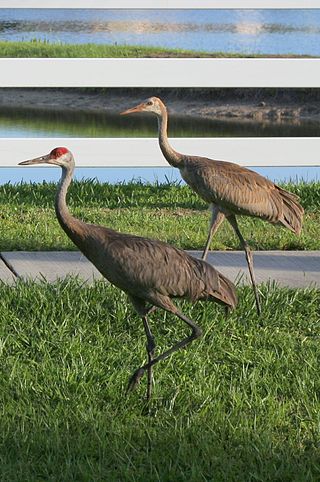
The sandhill crane is a species of large crane of North America and extreme northeastern Siberia. The common name of this bird refers to habitat like that at the Platte River, on the edge of Nebraska's Sandhills on the American Great Plains. Sandhill Cranes are known to hangout at the edges of bodies of water especially in the Central Florida region. This is the most important stopover area for the nominotypical subspecies, the lesser sandhill crane, with up to 450,000 of these birds migrating through annually.

The red-crowned crane, also called the Manchurian crane or Japanese crane, is a large East Asian crane among the rarest cranes in the world. In some parts of its range, it is known as a symbol of luck, longevity, and fidelity.

The Siberian crane, also known as the Siberian white crane or the snow crane, is a bird of the family Gruidae, the cranes. They are distinctive among the cranes: adults are nearly all snowy white, except for their black primary feathers that are visible in flight, and with two breeding populations in the Arctic tundra of western and eastern Russia. The eastern populations migrate during winter to China, while the western population winters in Iran and (formerly) in Bharatpur, India.

The demoiselle crane is a species of crane found in central Eurosiberia, ranging from the Black Sea to Mongolia and North Eastern China. There is also a small breeding population in Turkey. These cranes are migratory birds. Birds from western Eurasia will spend the winter in Africa while the birds from Asia, Mongolia and China will spend the winter in the Indian subcontinent. The bird is symbolically significant in the culture of India, where it is known as Koonj or Kurjaa.
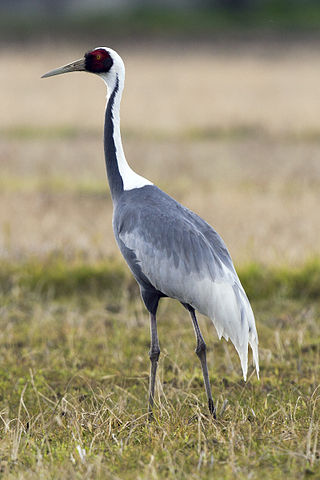
The white-naped crane is a bird of the crane family. It is a large bird, 112–125 cm (44–49 in) long, about 130 cm (4.3 ft) tall, and weighing about 5.6 kg (12 lb), with pinkish legs, a grey-and-white-striped neck, and a red face patch.

The black-necked Crane is a medium-sized crane in Asia that breeds on the Tibetan Plateau and remote parts of India and Bhutan. It is 139 cm (55 in) long with a 235 cm (7.71 ft) wingspan, and it weighs 5.5 kg (12 lb). It is whitish-gray, with a black head, red crown patch, black upper neck and legs, and white patch to the rear of the eye. It has black primaries and secondaries. Both sexes are similar. Some populations are known to make seasonal movements. It is revered in Buddhist traditions and culturally protected across much of its range. A festival in Bhutan celebrates the bird while the Indian union territory of Ladakh has designated it as the state bird.

The pied harrier is an Asian species of bird of prey in the family Accipitridae. It is migratory, breeding from the Amur valley in eastern Russia and north-eastern China to North Korea. Wintering individuals can be found in a wide area from Pakistan to Philippines. The population consists of approximately 10,000 individuals and the number is thought to be in moderate decline.
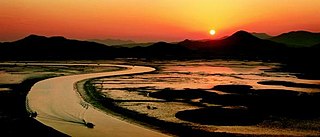
Suncheon Bay Ecological Park is a protected natural area near Suncheon, South Korea. It is a bay between Yeosu and Goheung peninsulas, located 8 km (5.0 mi) from the center of Suncheon, with 21.6 km2 (8.3 sq mi) of mudflats and 5.4 km2 (2.1 sq mi) of reed beds.

The Jagdishpur Reservoir is a reservoir in Jahadi Village Development Committee, Kapilvastu District, Nepal which was named after Er. Jagadish Jha who designed and supervised the construction of Banaganga dam. With a surface area of 225 ha (2.25 km2), it is the largest reservoir in the country and an important wetland site. It is situated at an altitude of 197 m (646 ft). The maximum water depth varies between 2 m (6.6 ft) in the dry season and 7 m (23 ft) in the monsoon season.
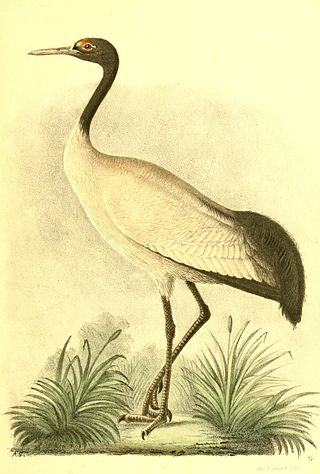
Black-necked cranes in Bhutan are winter visitors during late October to mid February to the Phobjikha Valley as well as Ladakh, India, and Arunachal Pradesh, India. They arrive from the Tibetan Plateau, where they breed in the summer. They visit the Phobjikha Valley in large numbers, which is a declared protected area for the cranes, and also to other valleys in smaller numbers in central and eastern Bhutan.
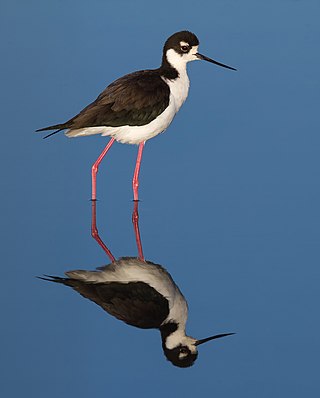
The black-necked stilt is a locally abundant shorebird of American wetlands and coastlines. It is found from the coastal areas of California through much of the interior western United States and along the Gulf of Mexico as far east as Florida, then south through Central America and the Caribbean to Brazil, Peru and the Galápagos Islands, with an isolated population, the Hawaiian stilt, in Hawaii. The northernmost populations, particularly those from inland, are migratory, wintering from the extreme south of the United States to southern Mexico, rarely as far south as Costa Rica; on the Baja California peninsula it is only found regularly in winter. Some authorities, including the IUCN, treat it as a subspecies of Himantopus himantopus.

Ŭllyul Kŭmsanp'o(은율금산포) is an 800 ha wetland wildlife reserve on the north-eastern shore of the Yellow Sea, on the west coast of North Korea in Ŭllyul County, South Hwanghae Province south of the estuary of the Taedong River. The site forms the core of a 1400 ha Important Bird Area (IBA), identified as such by BirdLife International because, with adjacent rice paddies, it supports populations of migrating and wintering water and wetland birds. Species using the site include swan geese, whooper swans, black-faced spoonbills, Chinese egrets, red-crowned cranes and Nordmann's greenshanks. The IBA is threatened by agricultural intensification.

Onchon Field is a 50,000 ha wetland site in South Pyongan Province of North Korea. It contains freshwater wetlands, rice paddies and salt pans. It has been identified by BirdLife International as an Important Bird Area (IBA) because it supports populations of swan geese, greater white-fronted geese, whooper swans, black-faced spoonbills, Chinese egrets, great bustards, white-naped cranes, hooded cranes and red-crowned cranes. It is threatened by agricultural intensification, aquacultural development and human disturbance.

Panmun Field(판문흰두루미살이터) is an 8000 ha wetland site in southern North Hwanghae Province of North Korea, close to the city of Kaesong and the border with South Korea. It contains mainly rice paddies. It has been identified by BirdLife International as an Important Bird Area (IBA) because it supports populations of swan geese, greater white-fronted geese, white-naped cranes, hooded cranes and red-crowned cranes. It is threatened by human disturbance.

The sarus crane is a large nonmigratory crane found in parts of the Indian subcontinent, Southeast Asia, and Australia. The tallest of the flying birds, standing at a height of up to 1.8 m, they are a conspicuous species of open wetlands in South Asia, seasonally flooded Dipterocarpus forests in Southeast Asia, and Eucalyptus-dominated woodlands and grasslands in Australia.

The Torey Lakes are a pair of soda lakes, Barun-Torey and Zun-Torey, in Russia's Zabaykalsky Krai, on the border with Mongolia.






















